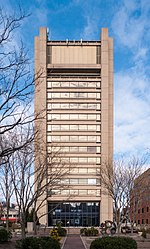Governor Henry Lippitt House
Governor of Rhode IslandHistoric American Buildings Survey in Rhode IslandHistoric district contributing properties in Rhode IslandHistoric house museums in Rhode IslandHouses completed in 1865 ... and 8 more
Houses in Providence, Rhode IslandHouses on the National Register of Historic Places in Rhode IslandItalianate architecture in Rhode IslandLippitt familyMuseums in Providence, Rhode IslandNRHP infobox with nocatNational Historic Landmarks in Rhode IslandNational Register of Historic Places in Providence, Rhode Island

The Governor Henry Lippitt House is a historic house museum at 199 Hope Street on the East Side of Providence, Rhode Island. A National Historic Landmark, it is one of the finest Italianate mansion houses in the state, and considered one of the best-preserved examples of Victorian-era houses in the US. It is notable for its association with Henry Lippitt (1818–91), a wealthy textile magnate who was the 33rd Governor of Rhode Island. The house is owned by Preserve Rhode Island, and is open to the public for tours seasonally or by appointment.
Excerpt from the Wikipedia article Governor Henry Lippitt House (License: CC BY-SA 3.0, Authors, Images).Governor Henry Lippitt House
Fones Alley, Providence
Geographical coordinates (GPS) Address Nearby Places Show on map
Geographical coordinates (GPS)
| Latitude | Longitude |
|---|---|
| N 41.828055555556 ° | E -71.397777777778 ° |
Address
Fones Alley
Fones Alley
02912 Providence
Rhode Island, United States
Open on Google Maps










